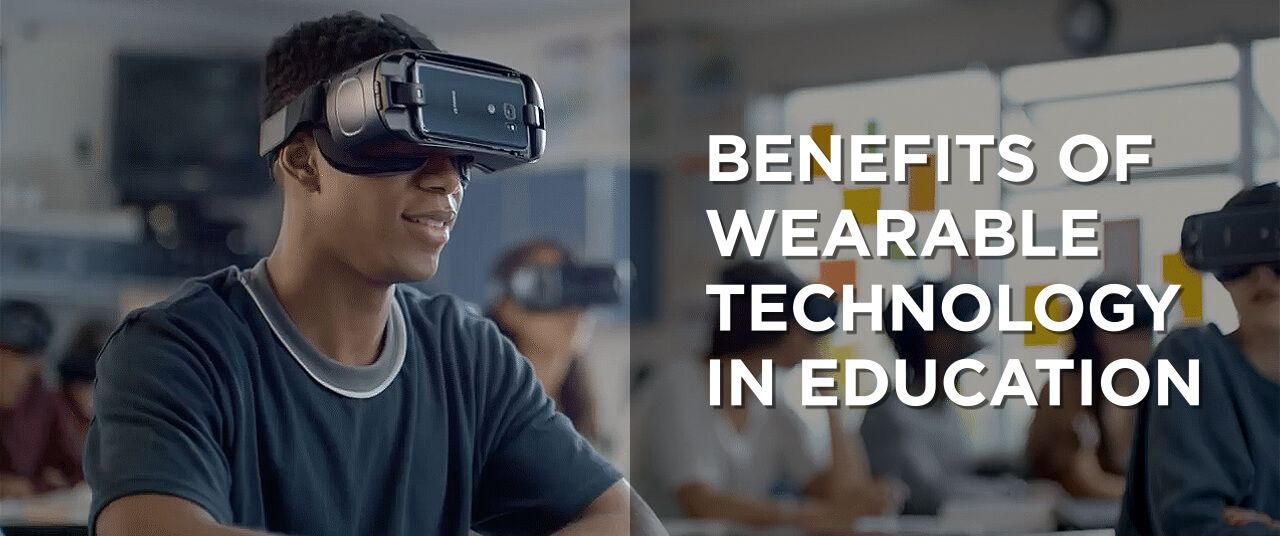Benefits of Wearable Technology in Education

In recent years, wearable technology has become a hot topic in a variety of domains. Statistics forecast that the global market size of connected wearable devices will exceed 1.1 billion by 2022. The new generation of wearable devices is more compact yet smarter, more powerful, and flexible than their predecessors. They can improve your punctuality, increase productivity, and provide you with more spare time.
The educational sphere is not an exception. Students can use wearables to listen to audio lessons, make voice notes, or receive notifications. Such technologies can also be beneficial to parents and teachers.
Undoubtedly, this technology can improve the educational system and generate a great deal of income for your business. But what exactly are the benefits of wearable technology in education? How can your business use them, and which wearable devices are leading the race?
In this article, we’ll answer these questions and tell you everything you need to know about wearable technology in education.

This statistic shows the forecast market value of connected wearable devices worldwide in 2016 and 2022. The global market size of connected wearable devices is expected to exceed 1.1 billion by 2022.
Here’s What We’ll Cover
- What Is Wearable Technology?
- How Wearable Tech Can Enhance Your e-Learning Solutions
- Disadvantages of Wearable Technology in the Education Process
- Wearable Technology in the Classroom
- How Safe Is Wearable Technology?
- How Much Does It Cost to Produce an App for a Wearable Device?
- Ready to Turn Your Idea into Reality and Build an Educational App for Wearables?
What Is Wearable Technology?
Wearable technology is a general term for hands-free devices powered by microprocessors and enhanced with the ability to send and receive data via Bluetooth, Wi-Fi, or cellular networks.
In a nutshell, wearable technology describes a group of devices, including fitness trackers and smartwatches, that are designed to be worn throughout the day, often called “wearables” for short. These technologies often require an app that exchanges data with the wearable device to perform functions such as tracking movement, organizing tasks, and providing location-specific information, among many more.
How Wearable Tech Can Enhance Your e-Learning Solutions
With increased adoption, how can wearable devices improve the learning and development process? Below, you’ll learn about some benefits to consider.
Enhanced Student Engagement
Wearable technologies are engaging educational tools that help students obtain firsthand information about any topic they choose. Teachers can use these wearables to come up with and share teaching schedules among students and teaching staff. This enables students to be informed about their timelines for assignment submissions and exam schedules, helping avoid any instances of miscommunication.
Hands-Free Convenience
Freeing up your hands is a common attribute of wearable technologies. For example, smart glasses can be a great tool for studying, allowing students to take notes without missing important topics during lectures.
Improved Student–Teacher Communication
Teachers can use wearables to conduct real-time classes without assembling all of their students under one roof. Students can send any queries to their teachers and enjoy better remote access to the study materials they need.
Cameras for Classrooms and Schools
Recorded lessons will come in handy for students who have missed a class or were absent for a day due to ill health or for other personal reasons.
Distance Learning
Students wearing smart glasses can obtain all the benefits of distance learning. They can enjoy holistic learning through lessons complete with practical illustrations that are presented by these tools.
The Smart Way To Learn History and Languages
Students can use VR headsets to visit former empires or foreign locations and cultures without stepping out of the classroom. This allows them to have authentic experiences that cannot be replicated through images, pictures, slideshows, or static maps.
Wearable Monitors for Kids
Smart wearable devices are useful not only for teachers and students but also for parents. For example, parents can use fitness bracelets and apps to check their kids’ health, know where they are, or monitor how many steps they take.
Disadvantages of Wearable Technology in the Education Process
Despite their advantages, wearables can also be a distraction. Wearable technology offers plenty of distractions due to the various features included by its creators.
Higher Prices
While you can pick up a fitness tracker at an affordable price these days, wearable devices that offer genuine benefits in educational contexts are often rather costly.
Not All Wearables Are Standalone
Some wearables require a connection to a smartphone or platform to ensure full functionality. In such cases, you may need to simultaneously bring in new systems along with wearables.
Wearable Technology Limitations
Despite advances in smart wearable technology, most devices are still held back and governed by technical limitations like battery capacity. This means that they can be both tricky to use and unreliable.
Privacy Concerns
Before adopting any wearable technology, it is crucial to first evaluate the potential impacts it will have on the people using it. For wearables to work effectively, they need to be fully trusted and clearly designed to fulfill a specific role within the education process.
The U.S. Center for Digital Democracy (CDD) study showed that loss of private information is more likely to occur in medical wearable devices. Consumers tend to expect more security than such technology actually provides.
Wearable Technology in the Classroom: What’s Available, and What Does It Deliver for Your Business?
Smartwatches
Smartwatches or smartbands can improve communication between teachers and students. They allow students to record lectures, take tests, and perform other subject-specific tasks. Students can send notes and voice messages to teachers and use their watches as an alarm or remote. They can also check their daily activity, pulse, steps, and so on.
Fitness Tracking Bands
Fitness trackers like Moki, Fitbit, and Adidas Zone help students monitor their daily fitness growth and progress over the length of a course. Gym teachers can track students as they reach their health and fitness goals and adjust their classes to accommodate students’ changing fitness levels.
Smart Glasses
Smart glasses can display directions and lead students to a classroom. Hands-free wearable devices also allow users to make calls, record and save video or audio, and take photos and videos. Teachers can communicate with students, monitor their process in doing work through the Google Glass camera, and communicate with them in real time.
Wearable Video Recorders
Wearable video recorders like GoPro allow teachers to record lessons for students who are absent. They can also be used to enhance the learning environment. These tools enable users to share their reality with others.
Wireless Earphones
This technology can be used for audio-based content consumption in schools. However, a more attractive option might be to use this technology to obtain comments during an art study or field trip or to receive instructions in a physical education lesson. This tool also allows students to instantly translate the teacher’s words into their native language.
Brain Sensor Headbands
Brain sensor devices transmit and record impulses of the brain in an app that is connected via a smartphone. The teacher can then check students’ activity and understandings of new information about a topic. Headband Muse is a successful example of how to record the state of the brain in an app.
Virtual Reality (VR) Headsets
VR devices allow users to be fully engaged in a real situation. Teachers can lead virtual tours through cities and events instead of relying on pictures, posters, and slideshows. For example, VR courses for students like ThingLink allow students to travel around the world using iPads, iPhones, or VR glasses.
Wearable Technology Enhances School Curricula—But How Safe Is It?
It should be mentioned that using wearables can involve privacy concerns. Before using such apps, we recommend that you follow these tips to protect your data when using wearable devices:
- Read the privacy policy and keep checking the updates. Some companies may legally or illegally share your personal information with third parties. By studying companies’ privacy policies, you can learn about the data the company collects and how those data are used or shared.
- Turn off location tracking and limit the personal information you share. Exact user location could allow malicious actors to identify your home address and workplace. Keep geolocation tracking turned off or control the amount of data collected by the wearable device.
- Tweak your privacy settings. Check and tweak the default privacy settings on your devices, as well as their associated apps and websites, to choose the most appropriate privacy controls. In addition, remember that some apps are connected to social media and can publish your data to a wider audience.
- Use a password and enable software updates. Check whether your wearable device allows you to set a security lock to ensure that your data remains safe in case your wearable is lost or stolen. You should also consider using a password each time you integrate your wearable into your smartphone. Last but not least, ensure that your device and apps are running with the latest security updates.
- Wipe personal info from old devices. If you’re no longer using or thinking of selling your wearable device, ensure that you’ve permanently removed all of your personal data. You can ask the manufacturer about the best way to wipe your device of personal data.
- Finally, check your credit reports to identify unknown or suspicious activity.
How Much Does It Cost to Produce an App for a Wearable Device?
The average cost of developing a wearable app varies greatly depending on the functions the app will have. Prices can start at $25,000. To find out more details or estimate your app’s cost, you can drop us a line.
You might also want to check out our article about app development costs and the factors that determine them.
Ready to Turn Your Idea into Reality and Build an Educational App for Wearables?
Wearable technology is more than just a buzzword. It can make education more accessible, meaningful, and engaging for students of all ability levels and interests.
If your business is ready to enter the wearable technology market, feel free to contact us. We’ll answer all your questions and provide you with a free estimate for your project.





William M says:
You mentioned that the development of an app for wearable technologies will cost $25,000 and more. But could you please say more clearly what is be the range and how is it formed? Personally I’m interested in VR app development cost, so what are the prices in this sphere?